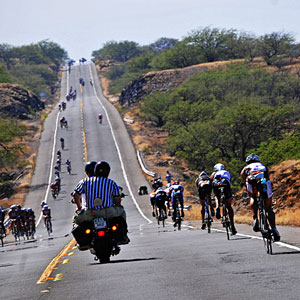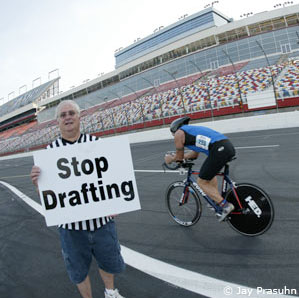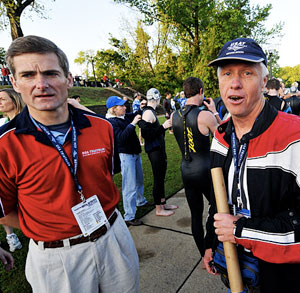Party in the penalty tent

Sometimes teachable moments are hard moments, for those being taught. This moment was prompted by threads discussing blog entries by professional athletes bemoaning penalties received during the Hawaiian Ironman.
One blog entry noted: "That is how it happened; I was riding along and then the pace slowed. I entered the draft zone by .5 meters and then got flashed a RED CARD." Another inexplicable penalty suffered by that same athlete was also described, during which a marshal "took her stop watch and started it right in front of my face as if to say, Take That, and after 30 seconds she flashed me a red card, called me for drafting and rode away."
Another pro athlete received a penalty when, according to her sponsor, "She could simply not complete the pass and had to pull back." This, according to the athlete, because an age-group male rider, during her pass attempt, "increased his speed significantly" requiring of this pro a "much harder energy burst" than originally anticipated to complete the pass.
It occurred to me that, notwithstanding thread after thread, year after year, spent by me about rules, maybe we still have a knowledge gap. This mundane and boring subject matter may, instead of instruct, cause our dear readers to wander over to the Lavender Room, seeking something juicier with which to occupy themselves. So, I thought a poll might help.
And here is what the poll—as of this moment several hours old and sitting on our site—asks: What do the rules say? If you find yourself too close to a rider in front of you, you should… Pass him? Drop back to the legal distance? Or, either action is legally okay?
As of this writing (we're just short of 250 votes), 10 percent of all respondents say "Drop back to the legal distance." A further 40 percent report that either dropping back, or completing the pass, is okay. Half the respondents maintain that you just complete the pass, that this is the only way to avoid the penalty.
Let us repair to the USA Triathlon Competitive Rules. Article V is entitled Cycling Conduct, and 5.10 of Article V refers to "Position Fouls." In 5.10(e) we read about "Passing": A participant who approaches another cyclist from the rear or from another unfavorable position bears primary responsibility for avoiding a position foul even if the cyclist being approached alters speed. A participant must not attempt to pass another cyclist unless adequate space is available and the athlete is confident of his/her ability to pass the other cyclist. All passing is to be done to the left of the cyclist being overtaken unless otherwise specified.
The conduct of the faster rider who seeks to pass is further amplified in 5.10(h) where the rules explain that you may avoid a penalty… When entering the drafting zone from the rear, closing the gap, and overtaking all within no more than 15 seconds.
The major exception to this is if you enter a drafting zone while executing a turn of at least 90°; in this case, you may drop back out of a draft zone without executing the pass.
So, it should be clearer, now, what the answer to the poll should be. If you find yourself riding too close to a rider in front of you, it's because you entered his draft zone, and in this case you should pass him! There is no other legal way to avoid a penalty. Furthermore, you have only 15 seconds to do this, and you must execute the pass even if the cyclist being approached alters speed.
Now, I believe this last phrase is a bad rule. I think that riders who speed up in an obvious effort to avoid being overtaken, thus forcing the passing rider into a penalty, is at fault, is guilty of bad sportsmanship, and should be the one receiving the penalty. While it's a bad rule in general, it discriminates against women in particular, because a lot of males will go to extraordinary lengths to avoid being passed by a woman. As we see in one of the cases above, this sort of behavior caused the disqualification of a top female pro, if this female's version of events is to be accepted.
Nevertheless, that's the rule as it now stands, and, it's stunning to note how many people don't know or understand it. In fact, it seems clear from the blog entries of the first pro, noted above, that she might not have comprehended that she needed to complete the pass, nor, in the case of her second noted offense, the reason for the marshal's holding up of the stopwatch. There is only one use for a stopwatch, if you're a marshal on a moto: to time how long you're in the draft zone prior to completing the pass. Once you're in the draft zone, you must complete the pass. Period. There is no dropping back out of the draft zone. There's only going forward, until the pass is completed. (That established, near the end of an Ironman bike ride I can understand if the female pro's judgment is impaired and she didn't comprehend the meaning of the stop watch.)
When is the pass completed? When the passing rider's front wheel crosses the plane of the overtaken rider's front wheel. At that point, the overtaken rider must drop back. This is the only time you are legally able to drop out the back of a draft zone: when you have been passed by a faster rider. You not only can drop back, you are obliged to. You must not attempt to repass the rider who's just passed you until you are completely out of his draft zone.
I cannot find a time interval mentioned in the rulebook telling riders how much time they have to move out of the draft zone. But move back they must, and they must do so "immediately," according to the rules.
What is the draft zone? Well, this is another rule that is quizzically written. It's defined by the leading edge of a rider's front wheel. It extends 7 meters backward, from the front wheel's leading edge. It is 2 meters wide, and the bike sits in the center of that 2 meters [5.10(b): the front wheel divides the short side of the zone into two
equal parts.]
Your bike has its own drafting zone too, as it turns out. And these drafting zones, like matter and antimatter, cannot ever intersect, except for the 15 seconds it takes for one rider to pass another. If they do otherwise intersect, the universe ceases to exist. And, you get a penalty.
So, what if you're only 3 meters behind that rider's front wheel—or you two are riding side-by-side for that matter—but you're 2.5 meters to the left of that rider? Your drafting zone and his aren't intersecting. Hence, you can ride that way for as long as you want, correct?
Well, no, because of rule 5.10(f) Position: Except for reasons of safety and when no advantage is gained, all cyclists shall keep to the right of the prescribed course unless passing.
So—and this is why I think the "draft zone," is quizzical to me—why does the draft zone have width? You can't pass on the right, and, you can't ride anywhere else but on the right, and, you can clearly be in the drafting zone as long as you're out the front of it in 15 seconds, so, where does draft zone "width" find any place in this discussion?
Does this mean you can ride right up the arse of another cyclist before swerving out from behind him, in order to "slingshot" ahead using his slipstream? Yes. Well, sort of yes. You're invading his draft zone, but, that's entirely legal as long as you're up and out of it in 15 seconds. But, there is this: Rule 5.10c): Right-of-Way: [in part] a cyclist shall not crowd the other participant and shall allow reasonable space for the other participant to make normal movement without making contact.
This Right-of-Way is a real judgment call. Well, they're all considered judgment calls. But this one is really hard to nail down. In general, my counsel is just to not ride in an unsafe manner. Then I think you'll be okay, and you can "slingshot" off another rider's draft—nothing in the rulebook expressly says you can't.
I'd like to say one final word about the pro women's race at the Hawaiian Ironman. I don't yet have a list of penalties, but from what I've heard they're going to have to put stadium seating in the penalty tents on the course if they call it this way next year. I feel bad for the girls in this sense: Every year they, their managers, their coaches and sponsors, ask the refs: Are you calling the high strike this year? And every year the answer is, "Yes." This isn't just Ironman I'm talking about, it's every big race everywhere. "Yes, we're calling it tight." And then, it doesn't happen.
This year they called the high strike in Hawaii. The men, for the most part, were prepared for it. Many of the women weren't. But one good thing may have come out of this new attention to the marshaling in Kona: You know the rules a little better now, don't you?




Start the discussion at slowtwitch.northend.network